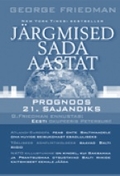 Predicting the course of international events is a risky business. The variables that go into a 100% accurate prediction are simply too many. Yet it is only human to try to divine the future, perhaps basic survival instinct has a part to play in this.
Predicting the course of international events is a risky business. The variables that go into a 100% accurate prediction are simply too many. Yet it is only human to try to divine the future, perhaps basic survival instinct has a part to play in this.US think-tank Stratfor founder and moving force George Friedman has put his vision of the future between the covers of The Next 100 Years, which is now available in Estonian as well through Ersen publishers.
Friedman makes no bones about the fact that his view is American-centric. In fact a main theme is persuading the reader that the true American era is not ending but yet to come. True, he does plot out a number of conflicts and obstacles that the US will have to surmount if it is to emerge victorious, culminating in World War III in the middle of the 21st century. After the war, a new golden era dawns, and this is the peak of the American age. Once again, however, the country finds itself mired in conflicts and problems, this time in its relations with Mexico.
Other than the WWIII scenario, which seems more literary than analytical, The Next 100 Years deserves serious consideration for its analysis and predictions of the future of the current powers.
Naturally Friedman’s ideas on the future of Russia have special interest for Estonia. The gist is the following: Russia will not be able to resist the temptation – if only due to geopolitics – to start restoring its empire on the territory of the former Soviet Union. This will inevitably lead to a deepening standoff with the Baltics and Poland. The US cannot withdraw support for the Baltics, as sacrificing these (by themselves insignificant) countries would set off panic in Central Europe, where the US has longstanding geopolitical interests at stake. Russia’s ageing population, weak economic, territorial fragmentation, disproportion spending aimed at remilitarization and many other factors lead to the country’s crumbling in 2020. To protect themselves from the threats stemming from the chaos in that direction, its neighbours are forced to take decisive action and take control of Russia’s peripheral regions. Among other things, Poland establishes direct control over Belarus, while Estonia would have to occupy St. Petersburg.
In the foreword, the author says he has no crystal ball and will likely not live so long to see which of his predictions come true and which prove false. Be that as it may. Anyone interested in international relations will find reading this book – and thinking along similar lines, critiquing or agreeing with the author’s arguments – exciting as a purely intellectual exercise. And that is a worthy result.





